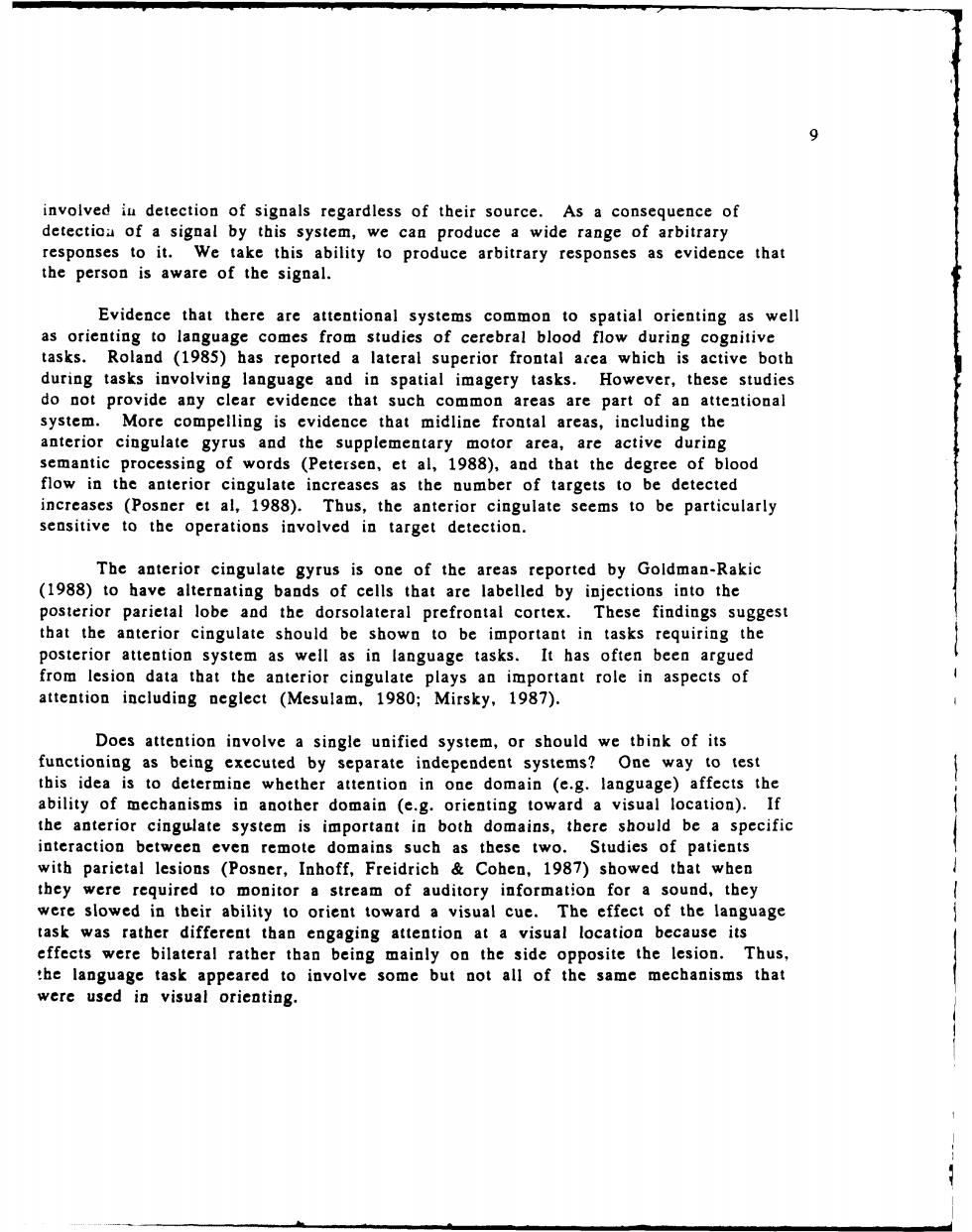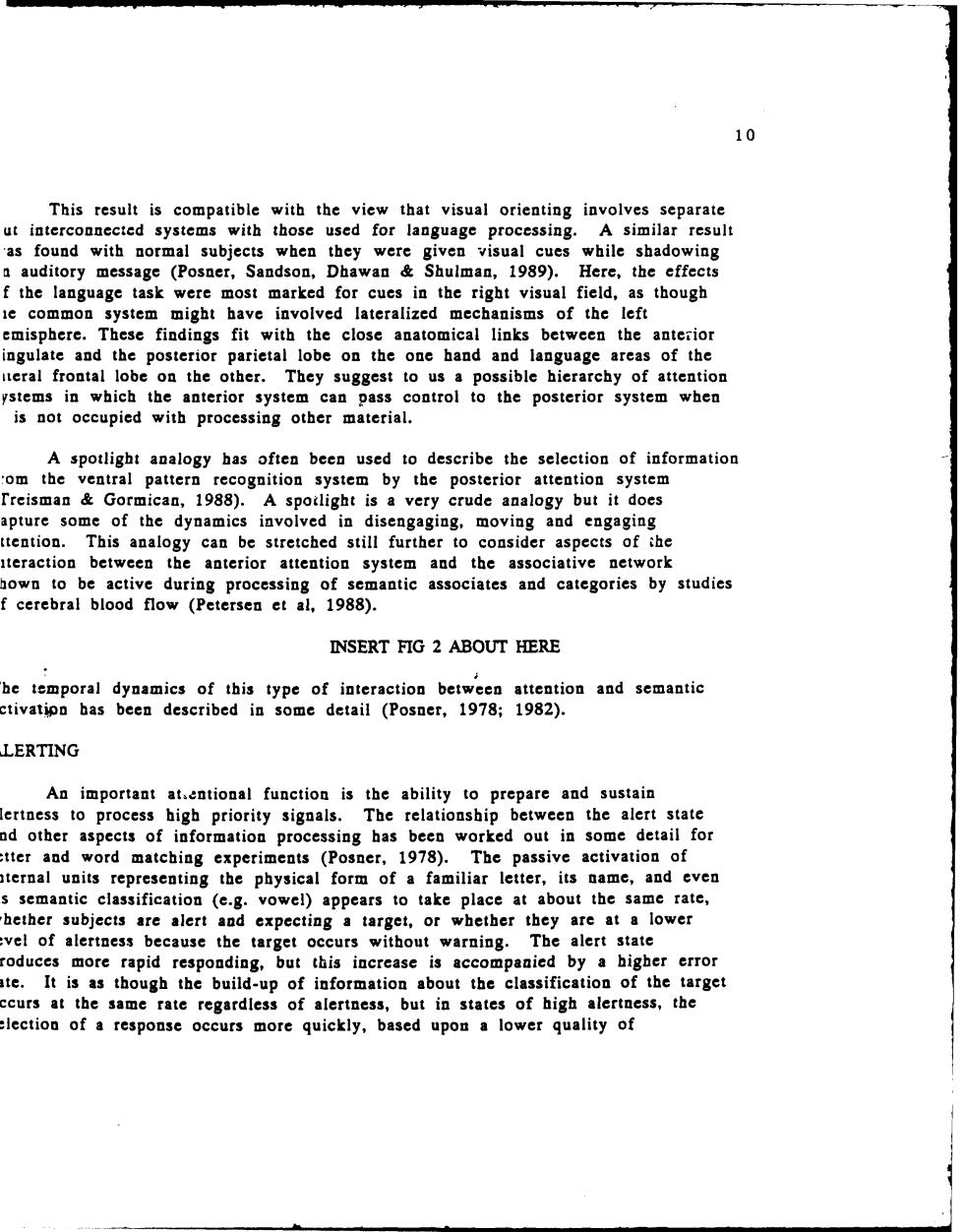
involved iu detection of signals regardless of their source.As a consequence of detectiou of a signal by this system,we can produce a wide range of arbitrary responses to it.We take this ability to produce arbitrary responses as evidence that the person is aware of the signal. Evidence that there are attentional systems common to spatial orienting as well as orienting to language comes from studies of cerebral blood flow during cognitive tasks.Roland (1985)has reported a lateral superior frontal acea which is active both during tasks involving language and in spatial imagery tasks.However,these studies do not provide any clear evidence that such common areas are part of an atteational system.More compelling is evidence that midline frontal areas,including the anterior cingulate gyrus and the supplementary motor area,are active during semantic processing of words (Petersen,et al,1988),and that the degree of blood flow in the anterior cingulate increases as the number of targets to be detected increases (Posner et al,1988).Thus,the anterior cingulate seems to be particularly sensitive to the operations involved in target detection. The anterior cingulate gyrus is one of the areas reported by Goldman-Rakic (1988)to have alternating bands of cells that are labelled by injections into the posterior parietal lobe and the dorsolateral prefrontal cortex.These findings suggest that the anterior cingulate should be shown to be important in tasks requiring the posterior attention system as well as in language tasks.It has often been argued from lesion data that the anterior cing rs an important role in aspects of attention including neglect (Mesulam 1980: Mirsky,1987). Does attention involve a single unified syst or should we tbink of its functioning y to test this idea ted by separ epe af ability (c.Ba ion) the 0 io 4 b spe cific par es (Posner, 081 6 e) e90 auditory informa s they ab orient owa cue the language was rathe differen tha engaging attention a ual locat were bilateral rather than being mainly on the side opposite the language task appeared to involve some but not all of the same mechanisms that were used in visual orienting
9 involved in detection of signals regardless of their source. As a consequence of detection of a signal by this system, we can produce a wide range of arbitrary responses to it. We take this ability to produce arbitrary responses as evidence that the person is aware of the signal. Evidence that there are attentional systems common to spatial orienting as well as orienting to language comes from studies of cerebral blood flow during cognitive tasks. Roland (1985) has reported a lateral superior frontal area which is active both during tasks involving language and in spatial imagery tasks. However, these studies do not provide any clear evidence that such common areas are part of an attentional system. More compelling is evidence that midline frontal areas, including the anterior cingulate gyrus and the supplementary motor area, are active during semantic processing of words (Petersen, et al, 1988), and that the degree of blood flow in the anterior cingulate increases as the number of targets to be detected increases (Posner et al, 1988). Thus, the anterior cingulate seems to be particularly sensitive to the operations involved in target detection. The anterior cingulate gyrus is one of the areas reported by Goldman-Rakic (1988) to have alternating bands of cells that are labelled by injections into the posterior parietal lobe and the dorsolateral prefrontal cortex. These findings suggest that the anterior cingulate should be shown to be important in tasks requiring the posterior attention system as well as in language tasks. It has often been argued from lesion data that the anterior cingulate plays an important role in aspects of attention including neglect (Mesulam, 1980; Mirsky, 1987). Does attention involve a single unified system, or should we think of its functioning as being executed by separate independent systems? One way to test this idea is to determine whether attention in one domain (e.g. language) affects the ability of mechanisms in another domain (e.g. orienting toward a visual location). If the anterior cingulate system is important in both domains, there should be a specific interaction between even remote domains such as these two. Studies of patients with parietal lesions (Posner, Inhoff, Freidrich & Cohen, 1987) showed that when they were required to monitor a stream of auditory information for a sound, they were slowed in their ability to orient toward a visual cue. The effect of the language task was rather different than engaging attention at a visual location because its effects were bilateral rather than being mainly on the side opposite the lesion. Thus, the language task appeared to involve some but not all of the same mechanisms that were used in visual orienting

10 This result is compatible with the view that visual orienting involves separate systems with those used for language processing. A similar result as ound subjects they were given visual cues while shadowing auditory me age (Posner,Sandson, Dhawan Shulman,1989). Here,the effects the language task were most marked for cues in the right visual field,as though common system might have involved lateralized mechanisms of the left These findings fit with the close anatomical links between the anterior ingulate the posterior parietal lobe on the one hand and language areas of the teral fro on the other. They suggest to us a possible hierarchy of attention the anterior system can pass control to the posterior system when i500 occupied with processing other material. spotligh analogy has often been use to describe the selection of information ognition pos attention system 19 very cru d :analogy but it does dynan ngaging, moving and engaging be stretched still further consider aspects of ihe teraction the anterior attention system and the ass ociative network be ac during processing of semantic associates and categories by studies cerebral blood (Petersen et al,1988). INSERT FIG 2 ABOUT HERE he temporal dynamics of this type of interaction between attention and semantic been described in some detail (Posner,1978;1982). LERTING An important at.entional function is the ability to prepare and sustain ertness to process high priority signals.The relationship between the alert state d other aspects of information processing has been worked out in some detail for tter and word matching experiments (Posner,1978).The passive activation of ternal units representing the physical form of a familiar letter,its name,and even semantic classification (e.g.vowel)appears to take place at about the same rate, hether subjects are alert and expecting a target,or whether they are at a lower vel of alertness because the target occurs without warning.The alert state oduces more rapid responding,but this increase is accompanied by a higher error te.It is as though the build-up of information about the classification of the target curs at the same rate regardless of alertness,but in states of high alertness,the lection of a response occurs more quickly,based upon a lower quality of
10 This result is compatible with the view that visual orienting involves separate ut interconnected systems with those used for language processing. A similar result as found with normal subjects when they were given visual cues while shadowing a auditory message (Posner, Sandson, Dhawan & Shulman, 1989). Here, the effects f the language task were most marked for cues in the right visual field, as though ie common system might have involved lateralized mechanisms of the left emisphere. These findings fit with the close anatomical links between the anterior ingulate and the posterior parietal lobe on the one hand and language areas of the iferal frontal lobe on the other. They suggest to us a possible hierarchy of attention ystems in which the anterior system can pass control to the posterior system when is not occupied with processing other material. A spotlight analogy has often been used to describe the selection of information om the ventral pattern recognition system by the posterior attention system rreisman & Gormican, 1988). A spotlight is a very crude analogy but it does apture some of the dynamics involved in disengaging, moving and engaging ttention. This analogy can be stretched still further to consider aspects of ^he iteraction between the anterior attention system and the associative network hown to be active during processing of semantic associates and categories by studies f cerebral blood flow (Petersen et al, 1988). INSERT FIG 2 ABOUT HERE 'he temporal dynamics of this type of interaction between attention and semantic ctivatign has been described in some detail (Posner, 1978; 1982). LERTING An important atantional function is the ability to prepare and sustain lertness to process high priority signals. The relationship between the alert state nd other aspects of information processing has been worked out in some detail for -tter and word matching experiments (Posner, 1978). The passive activation of iternal units representing the physical form of a familiar letter, its name, and even s semantic classification (e.g. vowel) appears to take place at about the same rate, 'hether subjects are alert and expecting a target, or whether they are at a lower :vel of alertness because the target occurs without warning. The alert state roduces more rapid responding, but this increase is accompanied by a higher error ite. It is as though the build-up of information about the classification of the target ccurs at the same rate regardless of alertness, but in states of high alertness, the election of a response occurs more quickly, based upon a lower quality of